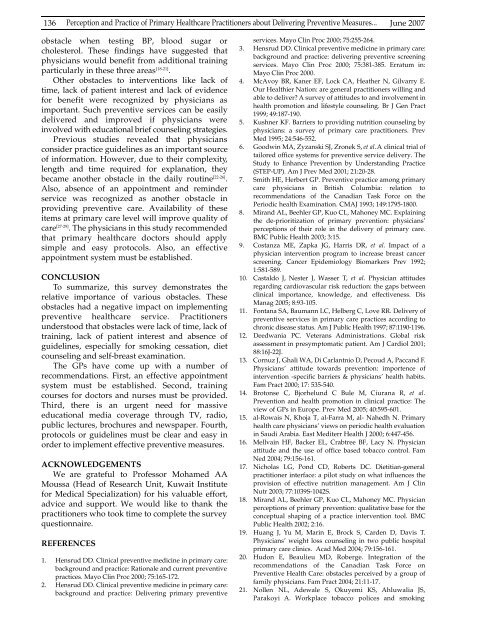Vol 39 # 2 June 2007 - Kma.org.kw
Vol 39 # 2 June 2007 - Kma.org.kw
Vol 39 # 2 June 2007 - Kma.org.kw
- No tags were found...
Create successful ePaper yourself
Turn your PDF publications into a flip-book with our unique Google optimized e-Paper software.
136Perception and Practice of Primary Healthcare Practitioners about Delivering Preventive Measures... <strong>June</strong> <strong>2007</strong>obstacle when testing BP, blood sugar orcholesterol. These findings have suggested thatphysicians would benefit from additional trainingparticularly in these three areas [18-21] .Other obstacles to interventions like lack oftime, lack of patient interest and lack of evidencefor benefit were recognized by physicians asimportant. Such preventive services can be easilyd e l i v e red and improved if physicians wereinvolved with educational brief counseling strategies.P revious studies revealed that physiciansconsider practice guidelines as an important sourceof information. However, due to their complexity,length and time required for explanation, theybecame another obstacle in the daily routine [22-26] .Also, absence of an appointment and reminderservice was recognized as another obstacle inp roviding preventive care. Availability of theseitems at primary care level will improve quality ofcare [27-29] . The physicians in this study recommendedthat primary healthcare doctors should applysimple and easy protocols. Also, an eff e c t i v eappointment system must be established.CONCLUSIONTo summarize, this survey demonstrates therelative importance of various obstacles. Theseobstacles had a negative impact on implementingp reventive healthcare service. Practitionersunderstood that obstacles were lack of time, lack oftraining, lack of patient interest and absence ofguidelines, especially for smoking cessation, dietcounseling and self-breast examination.The GPs have come up with a number ofrecommendations. First, an effective appointmentsystem must be established. Second, trainingcourses for doctors and nurses must be provided.T h i rd, there is an urgent need for massiveeducational media coverage through TV, radio,public lectures, brochures and newspaper. Fourth,protocols or guidelines must be clear and easy inorder to implement effective preventive measures.ACKNOWLEDGEMENTSWe are grateful to Professor Mohamed A AMoussa (Head of Research Unit, Kuwait Institutefor Medical Specialization) for his valuable effort,advice and support. We would like to thank thepractitioners who took time to complete the surveyquestionnaire.REFERENCES1. Hensrud DD. Clinical preventive medicine in primary care:background and practice: Rationale and current preventivepractices. Mayo Clin Proc 2000; 75:165-172.2. Hensrud DD. Clinical preventive medicine in primary care:background and practice: Delivering primary preventiveservices. Mayo Clin Proc 2000; 75:255-264.3. Hensrud DD. Clinical preventive medicine in primary care:background and practice: delivering preventive screeningservices. Mayo Clin Proc 2000; 75:381-385. Erratum in:Mayo Clin Proc 2000.4. McAvoy BR, Kaner EF, Lock CA, Heather N, Gilvarry E.Our Healthier Nation: are general practitioners willing andable to deliver? A survey of attitudes to and involvement inhealth promotion and lifestyle counseling. Br J Gen Pract1999; 49:187-190.5. Kushner KF. Barriers to providing nutrition counseling byphysicians: a survey of primary care practitioners. PrevMed 1995; 24:546-552.6. Goodwin MA, Zyzanski SJ, Zronek S, et al.A clinical trial oftailored office systems for preventive service delivery. TheStudy to Enhance Prevention by Understanding Practice(STEP-UP). Am J Prev Med 2001; 21:20-28.7. Smith HE, Herbert GP. Preventive practice among primaryc a re physicians in British Columbia: relation torecommendations of the Canadian Task Force on thePeriodic health Examination. CMAJ 1993; 149:1795-1800.8. Mirand AL, Beehler GP, Kuo CL, Mahoney MC. Explainingthe de-prioritization of primary prevention: physicians’perceptions of their role in the delivery of primary care.BMC Public Health 2003; 3:15.9. Costanza ME, Zapka JG, Harris DR, et al. Impact of aphysician intervention program to increase breast cancerscreening. Cancer Epidemiology Biomarkers Prev 1992;1:581-589.10. Castaldo J, Nester J, Wasser T, et al. Physician attitudesregarding cardiovascular risk reduction: the gaps betweenclinical importance, knowledge, and effectiveness. DisManag 2005; 8:93-105.11. Fontana SA, Baumann LC, Helberg C, Love RR. Delivery ofpreventive services in primary care practices according toc h ronic disease status. Am J Public Health 1997; 87:11 9 0 - 11 9 6 .12. Deedwania PC. Veterans Administrations. Global riskassessment in presymptomatic patient. Am J Cardiol 2001;88:16J-22J.13. Cornuz J, Ghali WA, Di Carlantnio D, Pecoud A, Paccand F.Physicians’ attitude towards prevention: importence ofintervention -specific barriers & physicians’ health habits.Fam Pract 2000; 17: 535-540.14. B rotonse C, Bjorhelund C Bule M, Ciurana R, et al.Prevention and health promotion in clinical practice: Theview of GPs in Europe. Prev Med 2005; 40:595-601.15. al-Rowais N, Khoja T, al-Farra M, al- Nahedh N. Primaryhealth care physicians’ views on periodic health evaluationin Saudi Arabia. East Mediterr Health J 2000; 6:447-456.16. Mellvain HF, Backer EL, Crabtree BF, Lacy N. Physicianattitude and the use of office based tobacco control. FamNed 2004; 79:156-161.17. Nicholas LG, Pond CD, Roberts DC. Dietitian-generalpractitioner interface: a pilot study on what influences theprovision of effective nutrition management. Am J ClinNutr 2003; 77:10<strong>39</strong>S-1042S.18. Mirand AL, Beehler GP, Kuo CL, Mahoney MC. Physicianperceptions of primary prevention: qualitative base for theconceptual shaping of a practice intervention tool. BMCPublic Health 2002; 2:16.19. Huang J, Yu M, Marin E, Brock S, Carden D, Davis T.Physicians’ weight loss counseling in two public hospitalprimary care clinics. Acad Med 2004; 79:156-161.20. Hudon E, Beaulieu MD, Roberge. Integration of therecommendations of the Canadian Task Force onPreventive Health Care: obstacles perceived by a group offamily physicians. Fam Pract 2004; 21:11-17.21. Nollen NL, Adewale S, Okuyemi KS, Ahluwalia JS,Parakoyi A. Workplace tobacco polices and smoking
















